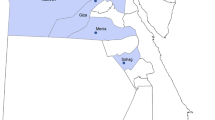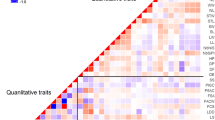Abstract
The genetic variation existing in a set of barley (Hordeum vulgare L.) landrace samples recently collected in Morocco was estimated. Two kinds of genetic markers, seed storage proteins (hordeins) and random amplified polymorphic DNA (RAPD), were used. Only six out of 31 landraces were subjected to RAPD analysis. Both kinds of markers, RAPD and storage proteins, yielded similar results, showing that the level of variation observed in Moroccan barley was high: all landraces showed variability; 808 different storage protein patterns (multilocus associations) were observed among 1897 individuals (2.32 seeds per association, on average) with an average of 43 multilocus associations per accession. In general, genetic variation within accessions was higher than between accessions. The 100 polymorphic RAPD bands generated by 21 effective primers were able to generate enough patterns to differentiate between uniform cultivars and even between individuals in variable accessions. One of the aims of this work was to compare the effectiveness of RAPD versus storage protein techniques in assessing the variability of genetic resource collections. On average hordeins were more polymorphic than RAPDs: they showed more alternatives per band on gels and a higher percentage of polymorphic bands, although RAPDs supply a higher number of bands. Although RAPD is an easy and standard technique, storage protein analysis is technically easier, cheaper and needs less sophisticated equipment. Thus, when resources are a limiting factor and considering the cost of consumables and work time, seed storage proteins must be the technique of choice for a first estimation of genetic variation in plant genetic resource collections.
Similar content being viewed by others
References
Ahokas H. and Poukkula M. 1999. Malting enzyme activities, grain protein variation and yield potentials in the displaced genetic resources of barley landraces of Finland. Genet. Resour. Crop Evol. 46: 251–260.
Allard R.W. 1999. History of plant population genetics. Ann. Rev. Genet. 33: 1–27.
Aman R.A. 1997. A comparative assessment of molecular techniques employed in genetic diversity studies (and their suitability in resource-limited settings). In: Ayad W.G., Hodgkin T., Jaradat A. and Rao V.R. (eds), Molecular Genetic Techniques for Plant Genetic Resources. International Plant Genetic Resource Institute, Rome, pp. 119–127.
Bahram N., Le Gouis J., Hariri D., Guilbaud L. and Jestin L. 1999. Genetic diversity of old French six-rowed winter barley varieties assessed with molecular, biochemical and morphological markers and its relation to BaMMV resistance. Heredity 83: 568–574.
Badr A., Müller K., Schäfer-Pregl R., El Rabey H, Effgen S, Ibrahim H.H. et al. 2000. On the origin and domestication history of barley (Hordeum vulgare). Mol. Biol. Evol. 17: 499–510.
Bekele E. 1983. A differential rate of regional distribution of barley flavonoid patterns in Ethiopia, and a view on the center of origin of barley. Hereditas 98: 269–280.
Bernardo A., Luque A., Cuadrado A., Negro A., Jouve N. and Soler C. 1997. The assessment of genetic variation in Spanish primitive cultivars of barley, Hordeum vulgare L., by a combination of isozymes and hordeins. Genet. Resour. Crop Evol. 44: 217–226.
Blattner F.R. and BadaniMández A.G. 2001. RAPD data do not support a second centre of barley domestication in Morocco. Genet. Resour. Crop Evol. 48: 13–19.
Dawson I.K., Chalmer K.J., Waugh R. and Powell W. 1993. Detection and analysis of genetic variation in Hordeum spontaneum populations from Israel using RAPD markers. Mol. Ecol. 2: 151–159.
Demissie A. and Bjornstad A. 1997. Geographical, altitude and agro-ecological differentiation of isozyme and hordein genotypes of landraces of barley from Ethiopia: Implication to germplasm conservation. Genet. Resour. Crop Evol. 44: 43–55.
Dellaporta S.L., Wood J.B. and Hicks J.B. 1983. A plant DNA minipreparation. version II. Plant Mol. Biol. Reports 1: 19–21.
Hedrick P.W. 1971. A new approach to measuring genetic similarity. Evolution 25: 276–280.
Karp A. and Edwards K.J. 1997. Molecular techniques in the analysis of the extent and distribution of genetic diversity. In: Ayad W.G., Hodgkin T., Jaradat A. and Rao V.R. (eds), Molecular Genetic Techniques for Plant Genetic Resources. International Plant Genetic Resource Institute, Rome, pp. 11–22.
Kraic J., Zakova M. and Gregova E. 1998. Comparison of differentiation capability of RAPD and SSR markers in commercial barley (Hordeum vulgare L.) cultivars. Cereal Res. Commun. 26: 375–382.
Kresovich S., McFerson J.R. and Westman A.L. 1997. Using molecular markers in genebank: identity, duplication, contamination and regeneration. In: Ayad W.G., Hodgkin T., Jaradat A. and Rao V.R. (eds), Molecular Genetic Techniques for Plant Genetic Resources. International Plant Genetic Resource Institute, Rome, pp. 23–38.
Laemmli U.K. 1970. Cleavage of structural protein during the assembly of the head of the bacteriophage T4. Nature 227: 680–685.
Molina Cano J.L., Fra Mon P., Salcedo G., Aragoncillo C., Roca de Tagores F. and García Olmedo F. 1987. Morocco as possible domestication center for barley. Biochemical and agromor phological evidences. Theor. Appl. Genet. 73: 531–536.
Molina Cano J.L., Gómez Campo C. and Conde J. 1982. Hordeum spontaneum Koch as a weed of barley fields in Morocco. Z. Pflanzenzücht 88: 161–167.
Nei M. 1978. Estimation of average heterozygosity and genetic distance from a small number of individuals. Genetics 89: 583–590.
Nielsen G. and Johansen H.B. 1986. Proposal for the identification of barley varieties based on the genotypes for 2 hordein and 39 isozyme loci of 47 reference varieties. Euphytica 35: 717–728.
Nevo E. 1992. Origin, evolution, population genetics and resources of wild barley, Hordeum spontaneum, in the Fertile Crescent. In: Shewry P.R. (ed.), Barley: Genetics, Biochemistry, Molecular Biology and Biotechnology. CAB International, Wallingford, UK, pp. 19–43.
Nevo E., Beiles A., Kaplan D., Storch N. and Zohary D. 1986. Genetic diversity and environmental associations of wild barley, Hordeum spontaneum (Poaceae), in Iran. Plant Syst. Evol. 153: 141–164.
Nevo E., Beiles A. and Storch N. 1983. Microgeographic edaphic differentiation in hordein polymorphism of wild barley. Theor. Appl. Genet. 64: 123–132.
Nevo E. and Payne P.I. 1987. Wheat storage proteins: diversity of HMW glutenin subunits in wild emmer wheat from Israel. 1. Geographical patterns and ecological predictability. Theor. Appl. Genet. 74: 827–836.
Owuor E.D., Fahima T., Beharav A., Korol A. and Nevo E. 1999. RAPD divergence caused by microsite edaphic selection in wild barley. Genetica 105: 177–192.
Papa R., Attene G., Barcaccia G., Ohgata A. and Konishi T. 1998. Genetic diversity in landrace populations of Hordeum vulgare L. from Sardinia, Italy, as revealed by RAPDs, isozymes and morphogenetic traits. Plant Breeding 117: 523–530.
Parzies H.K., Spoor W. and Ennos R.A. 2000. Genetic diversity of barley landrace accessions (Hordeum vulgare ssp. vulgare) conserved for different lengths of time in ex situ gene banks. Heredity 84: 476–486.
Pérez de laVega M. 1993. Biochemical characterization of populations. In: Hayward M.D., Bosemark N.O. and Romagosa I. (eds), Plant Breeding. Principles and Prospects. Chapman & Hall, London, U. K., pp. 184–200.
Pérez de laVega M. 1997. Plant genetic adaptedness to climatic and edaphic environment. In: Tigerstedt P.M.A. (ed.), Adaptation in Plant Breeding. Kluwer Academic Publishers, Dordrecht, The Netherlands, pp. 27–38.
Pérez de la Vega M. and García P. 1997. Genetic structure of self-pollinating species: the case of wild Avena. Bocconea 7: 141–152.
Pérez de la Vega M., Sáenz de Miera L. and Allard R.W. 1994. Ecogeographical distribution and differential adaptedness of multilocus allelic associations in Spanish Avena sativa L. Theor. Appl. Genet. 88: 56–64.
Saghai-Maroof M.A., Soliman K.M., Jørgensen R.A. and Allard R.W. 1984. Ribosomal DNA spacer-length polymorphism in barley: Mendelian inheritance, chromosomal location, and population dynamics. Proc. Natl. Acad. Sci. USA 81: 8014–8018.
Saitou N. and Nei M. 1987. The neighbor-joining method: A new method for reconstructing phylogenetic trees. Mol. Biol. Evol. 4: 406–425.
Selbach A. and Cavalli-Molina S. 2000. RAPD characterization of Brazilian barley (Hordeum vulgare L.) varieties. Euphytica 111: 127–135.
Shewry P.R., Parmar S., Franklin J. and White R. 1987. Mapping and biochemical analysis of Hord 4 (HrdG), a second locus encoding B hordein seed proteins in barley (Hordeum vulgare L.). Genet. Res. 48: 5–12.
Shewry P.R., Pratt H.M., Charlton M.J. and Miflin B.J. 1978a. Genetic analysis of hordein polypeptides from single seeds of barley. Heredity 40: 463–466.
Shewry P.R., Pratt H.M. and Miflin B.J. 1978b. Varietal identification of single seeds of barley by analysis of hordein polypeptides. J. Sci. Food. Agric. 29: 587–596.
Sneath P.H.A. and Sokal R.R. 1973. Numerical taxonomy. The principles and practices of numerical classification. W. H. Freeman, San Francisco.
Tinker N.A., Fortin M.G. and Mather D.E. 1993. Random amplified polymorphic DNA and pedigree relationships in spring barley. Theor. Appl. Genet. 85: 976–984.
Vapa L. and Radović D. 1998. Genetics and molecular biology of barley hordeins. Cereal Res. Commun. 26: 31–38.
White J. and Cooke R.J. 1992. A standard classification system for the identification of barley varieties by electrophoresis. Seed Sci. Technol. 20: 663–676.
Yasuda S., Hayashi J. and Moriya I. 1993. Genetic constitution of spring growth habit and some characters in barley cultivars in the Mediterranean coastal regions. Euphytica 70: 77–83.
Author information
Authors and Affiliations
Corresponding author
Rights and permissions
About this article
Cite this article
Dakir, EH., Ruiz, ML., García, P. et al. Genetic variability evaluation in a Moroccan collection of barley, Hordeum vulgare L., by means of storage proteins and RAPDs. Genetic Resources and Crop Evolution 49, 619–631 (2002). https://doi.org/10.1023/A:1021228730714
Issue Date:
DOI: https://doi.org/10.1023/A:1021228730714




